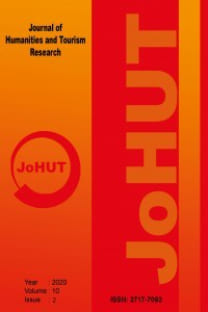Yayalaştırmanın Turist Kamusal Alan Kullanımı Üzerine Etkileri, Kuzey Kıbrıs Lefkoşa Surlariçi Örneği
Yayalaştırma tarihi kentlerin değerlerinin yeniden kazanılmasına katkıda bulunabileceği gibi kamusal alanlarda turist kullanımının gelişmesi için de büyük bir potansiyel oluşturmaktadır. Tarihi kent merkezlerinin yayalaştırılması, çeşitli turist odaklı kullanımlar için fırsatlar sunarak birçok sosyal, ekonomik ve fiziksel avantajlar da sağlayabilmektedir. Lefkoşa Surlariçi, Avrupa'nın son bölünmüş başkentidir ve bugün iki ayrı devlete ev sahipliği yapmaktadır. Tampon bölge, kuzey ve güney Lefkoşa arasındaki sınırı oluşturmaktadır. 2008 Yılında Lefkoşa'nın Surlarla Çevrili iki bölümü arasında yer alan Lokmacı Kapısı geçişlere açılmıştır. Kapının açılması, hem turizm potansiyelinin gelişmesinde hem de tarihi Kent’in canlandırılmasında önemli bir katkı sağlamıştır. Lefkoşa Surlariçi, Lokmacı geçidi'nin açılmasının ardından, yayalaştırma ile birlikte önemli bir çekim merkezi olmuştur. Lokmacı geçişinin açılmasından önce, bozulmaya ve özelliklerini kaybetmeye başlayan kamusal alanlar, kapının açılmasıyla birlikte önemli bir kamusal alana dönüşmeye başlamıştır. Devlet ve yerel otoriteler ile turizm aktiviteleri ele alınarak, tarihi kent merkezinin yeniden canlandırılması için yayalaştırma yapılmıştır. Bu çalışmanın amacı, yayalaştırmanın turist kamusal alan kullanımı üzerindeki sosyal etkilerini incelemektir. Lefkoşa Surlariçi’nin kuzey kesimindeki turist sosyal aktivitelerini ve kullanıcılarını belirlemek üzere gözlemsel analizler yapılmıştır. Çalışmanın son bölümünde ise bulgulara yönelik önerilere yer verilmiştir.
Anahtar Kelimeler:
Yayalaştırma, Kamusal Alan, Turist Kullanımı, Tarihi Kentsel Mekan, Lefkoşa Surlariçi
The Social Impacts of Pedestrianization on Tourist Public Space Usage Case Study: Nicosia Walled City, North Cyprus
Pedestrianization can contribute to restoring the values of historic cities and also create great potential for the development of tourist usage in public spaces. The pedestrianization of the historic city centres can bring many social, economic and physical benefits by offering diverse opportunities for various tourist-oriented uses. Nicosia Walled City is the last divided capital in Europe and hosts two separate states today. A buffer zone creates the border between Northern and Southern Nicosia. In 2008, a gate was opened between the two parts of Nicosia Walled City called Lokmacı Gate. The opening of the gate has an important role in both the development of tourism potential and the revitalization of the historical part of the City. Nicosia Walled City is a significant historic urban corner that the pedestrianization project was implemented after the opening of the Lokmacı Gate. The public spaces, which began to deteriorate and lose their characteristics before the opening of the Lokmacı Gate, have started to transform into important public spaces with the opening of the Gate. Pedestrianization can help to vitalize the historic city center through tourism facilities that are applied by the collaboration of the local and governmental authorities. This study is aimed to examine the social impacts of pedestrianization on tourist public space usage. On-site observations were carried out to determine the types of tourist activities and usage in the Northern part of the Nicosia Walled City. According to the findings, the recommendations were given in the final section of the paper.
Keywords:
Pedestrianization, public space, tourist uses, historic urban corner, Nicosia Walled City,
___
- Akyüz, M. and Zengin, B. (2012). The Affect of Pedestrianization of Historic Areas on Tourist Satisfaction: The Sample of Sultanahmet Square. International Journal of Social and Economic Sciences 2 (2), 89-94.
- Demir, H. H., Çakıroğlu, I., Alyüz, U and Demir, G. (2016). Evaluation Environmental and Social Impacts of Pedestrianization in Urban Historical Areas: Istanbul Historical Peninsula Case Study. Journal of Traffic and Logistic Traffic Engineerin, 4(1), 83-87.
- Güvenbaş, G. and Polay, M. (2019). Disabled Tourists Access at Kyrenia Sea Front, 4th International Tourism Congress, City Tourism, Eskişehir, October 16-19, 2019, 241-251.
- Iranmanesh, N. (2008). Pedestrianisation a Great Necessity in Urban Designing to Create Sustainable City in Developing Countries, 44th ISOCARP Congress, 2008.
- Jou, K.K. (2011). Pedestrian Areas and Sustainable Development, World Academy of Science,Engineering and Technology, International Journal of Architectural and Environmental Engineering, 5(5), 228-235.
- Monitoring, Coordination and Steering Committee of Nicosia Walled City, (2008). The Strategy of Conservation, Revitalization and Development, Prime Ministry, Nicosia.
- Orbaşlı, A., (2008). Architectural Conservation: Principles and Practice, Blackwell, Oxford.
- Project for Public Spaces (PPS). (2000). How to turn a place around: A handbook for creating successful public spaces. New York: Project for Public Spaces Soni, N., Soni, N. (2016). Benefits of Pedestrianization and Warrants to Pedestrianization and Area, Land Use Policy, 57, 139-150.
- Uzunoğlu, K. and Uzunoğlu, S. (2020). The Importance of Pedestrianization in Cities-Assessment of Pedestrianized Streets in Nicosia Walled City. European Journal of Sustainable Development, 9 (2), 589-614.
- Vehbi, B.O. (2014). Changing Impacts of Mass Tourism on Different Contexts in Northern Cyprus. Tourism, Travel and Leisure Travel: Tourism and Travel Studies Conference, June 5-7, 2014, 21-35.
- Woolley, H. (2003). Urban Open Spaces, Spon Press, New York.
- Yassin, H.H. (2019). Livable City an Approach to Pedestrianization through Tactile Urbanism, Alexandria Engineering Journal, 58, 251-259.
- Zukin, S. (1995). The Cultures of Cities, Blackwell Publishing, Oxford.
- https://www.reddit.com/r/MapPorn/comments/or1o1e/map_of_nicosias_oldwalled_city_divided_between/ (accessed, November 05, 2021).
- ISSN: 2717-7092
- Başlangıç: 2010
- Yayıncı: Karabük Üniversitesi
Sayıdaki Diğer Makaleler
Turizm Alanında Kişilik Özellikleri ile İlgili Lisansüstü Tezlerin Bibliyometrik İncelemesi
Afrika Boynuzu Ülkelerinin Siyasal Yapısına Giriş
Helal Turizm Trendleri: Kuşaklar Üzerine Bir Uygulama
Gizem GÜVENBAŞ, Mukaddes POLAY
Osmanlı Duvar Resimlerinde Antik Kent Kalıntılarının Bir Tema Olarak Kullanılması Üzerine
